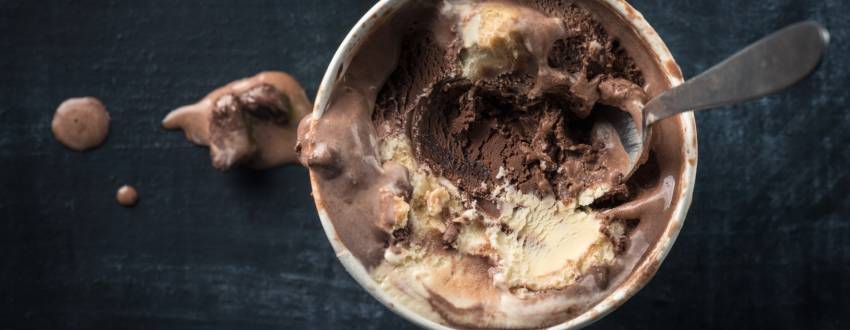If it ain’t broke, don’t fix it. That’s my general philosophy about many “tried and true” traditional holiday recipes. I’ve been using the same hamantaschen recipe for the past 25 years: it’s reliable, forgiving, and most importantly, beloved by those who snatch hamantaschen when I am not looking.
That said, the hamantaschen “revolution” of the past ten years has offered a sea of innovative hamantaschen recipes and ideas that can be confusing to navigate. Which kind of leavener to use, oil vs. margarine, chilled or ready-to-use…and the list goes on. The question remains: what makes for a great hamantaschen dough?
To see the effects of different ingredients and how the results compare, I used my aforementioned family recipe as a control and then began to play. Here are the results!
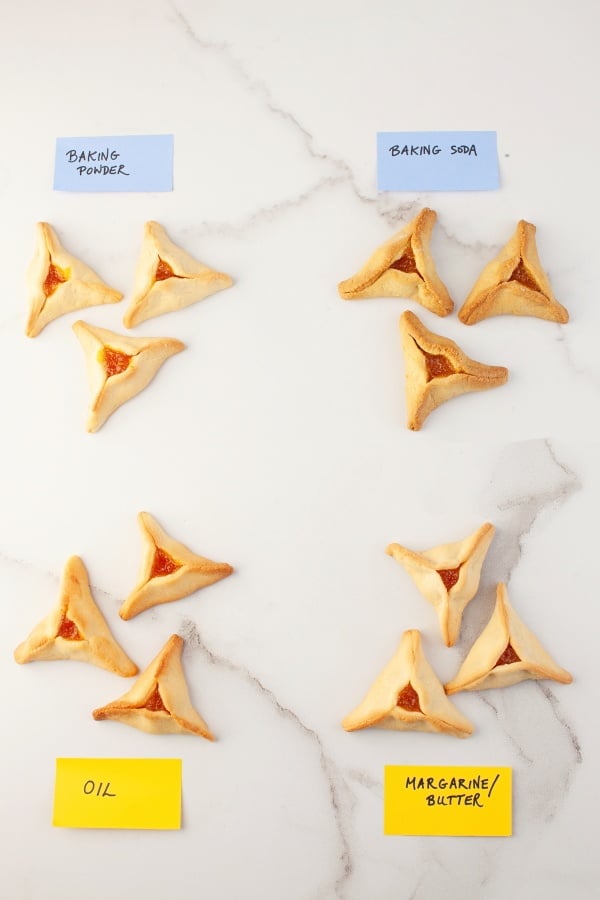
Hamantaschen Dough Made With Baking Powder:
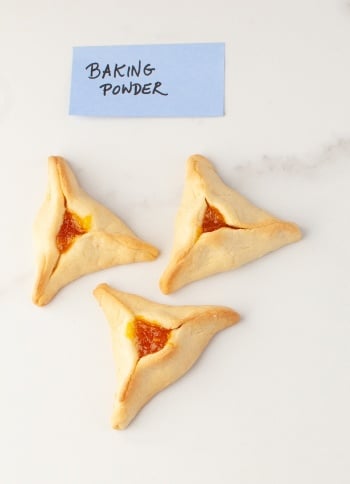
Baking powder is a standard leavener used in most hamantaschen recipes, as it offers good rise without altering the taste or color that much. Since the texture of hamantaschen is a cross between a cake and cookie, baking powder works well to produce the desired light browning. This was the case in batch 1 (my original recipe), which came out with a beautiful lightly golden hue and with a just enough “cakey” texture.
Hamantaschen Dough Made With Baking Soda:
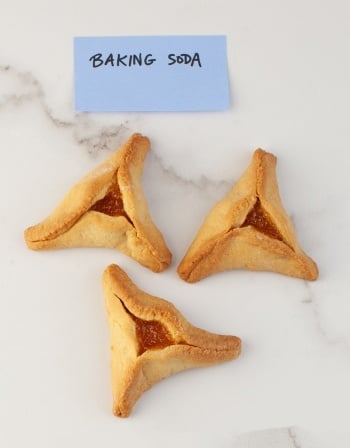
Making hamantaschen with baking soda was a good reminder that it’s not the same as baking powder. Baking soda is sodium bicarbonate and has a high Ph level (alkaline). When mixed with a low Ph level acid (like lemon juice or brown sugar), its chemical reaction will produce carbon dioxide, which helps to leaven baked goods. Without the acid present, however, it can lend a bitter taste and brown excessively.
As baking soda is approximately three times as powerful as baking powder (which is also sodium bicarbonate, but mixed with acids), I reduced the amount of baking soda in the recipe, adding only a third of the baking powder the recipe called for. My recipe calls for orange juice, so I hoped the acid would balance its reaction in the dough. Apparently, not enough. The dough over-browned in the same amount of baking time, leaving a comparatively hard, crunchy texture; and it had a slightly bitter off-taste. My children winced.
Hamantaschen Dough With Oil:
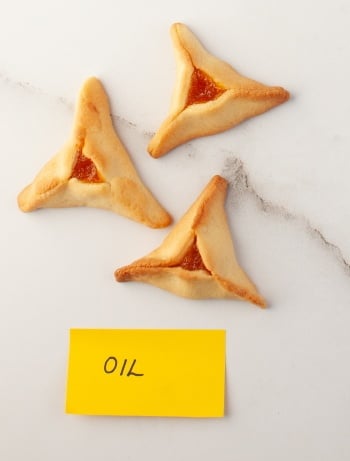
These days, for health reasons, we all gravitate towards recipes using oil instead of saturated or hydrogenated fats like butter or margarine. Luckily for us, oil-based doughs work beautifully, roll out well, and maintain a good texture (and remain parve!).
While the dough was definitely softer to work with than a margarine/butter-based dough, it turned out tasty hamantaschen that had a crisp edge to the cookie. Because it was a softer and slightly wetter dough, I definitely needed to flour my surface and pin generously and more often than with a margarine/butter-based dough (which is firmer and a bit dryer).
Hamantaschen Dough Made With Margarine/Butter:

While less healthy, these were the winner in our family taste test. The dough had a perfect balance between cakey and chewy texture, tender while still maintaining a crisp edge. They also browned nicely, achieving a light and golden color. Taste-wise, the added buttery flavor in the fat used enhanced the flavor more than the neutral-flavored oil (obviously even more so if you use real butter!).
The Bottom Line:
What kind of texture do YOU prefer in your hamantaschen? Do you like a more cookie-like hamantasch? Then go with an oil-based recipe. Love the taste of butter in your baked goods? Then a margarine/butter-based recipe is the one for you. Baking is a science, so the more you know about how your ingredients behave, the closer you’ll be to finding the hamantasch that’s right for you.
My Family’s Hamantaschen Recipe:
A reliable family recipe from my Aunt Susan who used to teach Jewish baking at her JCC many years ago. She still makes them every year…and so do I!
Ingredients:
1 cup butter or margarine or shortening
1 cup sugar
3 eggs
1/3 cup orange or pineapple juice
1 teaspoon pure vanilla extract
4 and 1/2 cups all-purpose flour (plus more for rolling)
4 and 1/2 teaspoons baking powder
1/4 teaspoon salt
Assorted pie fillings or preserves – apricot, raspberry, prune, lekvar (poppy)
Directions:
- Cream the shortening and sugar together in a large mixing bowl until a grainy paste forms. Beat in eggs, juice and vanilla until well blended.
- In a separate large bowl, sift together the flour, baking powder and salt. Slowly add the flour mixture to the batter, a little at a time, mixing just until the dough comes away from the sides of the bowl and forms into a ball. Refrigerate for at least two hours.
- Preheat oven to 350 degrees. Line baking sheets with parchment paper. Divide the dough into three to four parts. Working in batches, roll out the dough on a floured board (it helps to flour your rolling pin as well), until it is very thin – about 1/8 to 1/4 inch thick. Using a three-to-three-and-a-half-inch diameter cookie cutter or glass, cut circles in the dough.
- Place 1/2 to 3/4 teaspoon of filling in the center of each circle. Shape into a triangle by folding two sides of the circle to the center and pinch together at the sides. Fold remaining side up to the center and pinch together at the sides. Some of the filling should be visible in the center. Transfer hamantaschen to prepared baking sheets spaced one-inch apart. Bake for 13 to 15 minutes, until light golden brown (be careful not to overcook). Repeat with remaining dough and dough scraps.
Yield: 5 to 6 dozen
Photography by Baila Gluck




